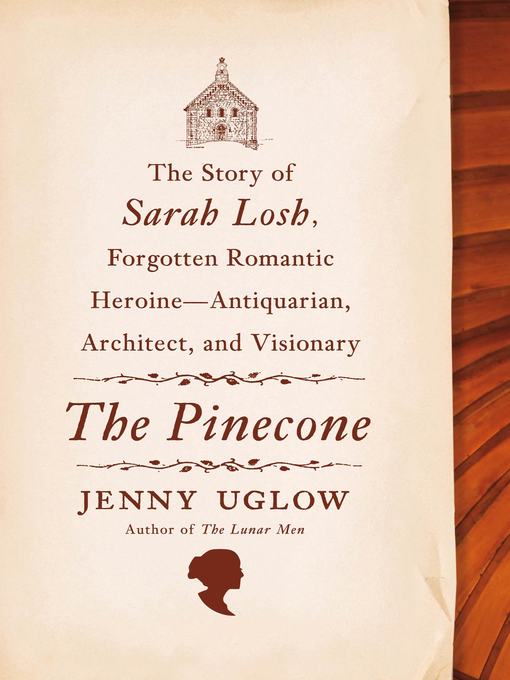
The Pinecone
The Story of Sarah Losh, Forgotten Romantic Heroine--Antiquarian, Architect, and Visionary
کتاب های مرتبط
- اطلاعات
- نقد و بررسی
- دیدگاه کاربران
نقد و بررسی

Starred review from November 5, 2012
Biographer Uglow (The Lunar Men) redirects her attention and the same painstaking care she's brought to historical giants (including Charles II and William Hogarth) to the obscure figure of an Industrial Revolution heiress and Victorian architect, Sarah Losh. Born in England in 1786, Losh's life took in the era's most progressive politics, arts, and technology while she rarely strayed far from her family's mansion, Woodside, in the northern town of Wreay, Cumbria. Raised in the same area, Uglow first heard of Losh through her most lasting achievement, an idiosyncratic church that pre-empted the pre-Raphaelites and embraced wildly varied cultural influences while downplaying the expected trappings of Anglicanism and even Christianity. Uglow's research uncovered a restlessly inquisitive woman, unusually independent from her era's ideas, as well as fascinating supporting characters like Losh's father, John, whose wide-ranging scientific interests led to their industrial fortune, her radical reformer uncle James, and, in a cameo, family friend William Wordsworth. By the end of the book, mystery remains around the church's bizarre pinecone-centric symbolism and Losh herself, who burned many of her papers before her death in 1853. Her voice's relative absence should not, however, diminish anyone's enjoyment of Uglow's achievement in spinning a tale of Victorian church building into a captivating epic. Agent: Melanie Jackson.

November 15, 2012
This elegant biography of a little-known Cumbrian landowner, builder and local daughter captures the rural and industrial changes in Georgian England. Accomplished British historian Uglow (A Gambling Man: Charles II and the Restoration, 2010, etc.) ably depicts the picturesque landscape of Carlisle, just south of the Scottish border. As the eldest daughter of deep descendants of the Wreay landed gentry, who pioneered the iron and alkali works feeding the Industrial Revolution, Sarah Losh (1785-1853) and her beloved younger sister, Katharine, did not feel compelled to marry and relinquish their independence. Rich from their father's and uncles' early industriousness, well-educated, strong-willed and bookish, the daughters were able to travel to Italy and elsewhere to study art and architecture, and they brought their ideas home to "improve" their estate and local structures such as the Carlisle school and church. After the death of her sister in 1834, Sarah threw herself into the work of building, combining her love of poetry, antiquities and her ancient land into a distinct, original style that was not Gothic, but that melded simple, rustic elements of the old Saxon and Norman, what she considered Lombard Romanesque. Employing in the woodwork designs of available flora and fauna like eagles and pine cones, Sarah embarked on work as a sculptor herself. With a light touch, Uglow integrates greater historical developments--e.g., the Napoleonic wars and the development of Romanticism--within an intimate bucolic story of people whose life was the land. A writer who knows her subject intimately creates a fully fleshed portrait of an England that would soon vanish with the advent of the railroads.
COPYRIGHT(2012) Kirkus Reviews, ALL RIGHTS RESERVED.

Starred review from January 1, 2013
Uglow takes such delight in her work that every page shimmers and whirls. On a mission to rescue neglected, radical English artists, such as Thomas Bewick (Nature's Engraver, 2007), she now richly and inquisitively portrays brainy and independent Sarah Losh (17861853). Uglow grew up in Cumbria, Losh's home territory, and knows well the wildly unconventional church Losh designed and built in the village of Wreay, a house of worship brimming with imagery drawn from Greek, Roman, Egyptian, Hindu, and Buddhist traditions, all shaped by Losh's passion for fossils and science. Losh even helped craft the carved stone and wood vines, lotus flowers, dragon, butterflies, raven, bat, eagle, stork, and her favorite, the pinecone, an ancient symbol of regeneration, fertility, and inner enlightenment. What sort of Victorian Englishwoman would construct a pantheistic temple? Bright, willful, and soon motherless, young Losh was supported in her quest for education by her wealthy industrialist father (Uglow's history of the family fortune is fascinating) and progressive uncle. Losh deflected her suitors to live a liberated life with her beloved sister, whose death precipitated Losh's phenomenal surge of creativity. Uglow expertly sets Losh's singular story within a historical context as intricately detailed and vital as Losh's church as she shares her profound appreciation for this visionary and her defiant celebration of life and art. (Reprinted with permission of Booklist, copyright 2013, American Library Association.)




















![Design Like You Give a Damn [2]](https://dl.bookem.ir/thumbnails/150/ISBN13/9781613122860.jpg)




دیدگاه کاربران